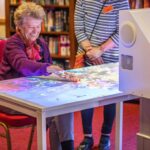
Many older adults living in long-term care, facing physical, financial or other limitations, can only dream about taking a real trip somewhere.
They can, however, fulfill their wanderlust through “virtual tourism” made possible by state-of-the-art virtual reality technology called the Broomx MK360.
Not only does such VR travel open the world for seniors in long-term care to experience but, in doing so, it also offers a number of benefits that significantly improve the quality of their lives.
And as an added plus, long-term-care staff can also take a much-needed virtual holiday and enjoy the rewards of relaxation away from their stressful jobs.
The Broomx MK360, developed in Spain, is now being distributed in North America by Sensory One. It offers a fully immersive experience by projecting a video that stretches across three walls and onto the ceiling, filling a user’s entire field of vision.
The platform comes pre-loaded with 100 different videos that include travel and nature from some of the most beautiful parts of the world, and adventures ranging from guided meditations to fun escapes on roller coasters. A local media company is working on more videos that will be focused on experiences in Canada.
The platform creates these escapes without the need to use headphones. And unlike other machines that require multiple projectors, the Broomx MK360 is the only full mobile, all-in-one unit.
Travel is well-known to provide stress relief at every stage of life. A break from everyday routines, seeing new landscapes, learning about other cultures and just relaxing are some of the restorative benefits of a vacation.
However, as people age, the barriers to getting away increase. Health and other issues can make travel physically difficult and financially impossible.
Studies have shown that living in “collective dwellings,” such as care facilities, is often associated with an increase in depression, loneliness and decreased functioning, adversely affecting health outcomes brought about by aging and living in such facilities.
But now, a feasibility study from Ryerson University has shown that virtual tourism provides many of the same positive outcomes as real travel without residents actually leaving a care facility.
The study’s participants were older adults, with a mean age of 82, living in care facilities in Toronto. They were shown three 10-minute virtual tours every week for six weeks. The study found participants had a decrease in anxiety and an increase in happiness and excitement. They also experienced a significant improvement in social engagement by talking to their families, caregivers and fellow residents about their experiences.
“Qualitative interview data suggest that the virtual tourism program was a positive and enjoyable experience that led to anticipation, social engagement, enjoyment, and escape,” the study’s author reported. “Taken together, these findings suggest that older adults not only enjoyed virtual tourism, but that virtual tourism provided a sense of escape and pause from daily life, as well as an activity to anticipate.”
Care facilities using the Broomx MK360 have found similar results.
“We are surprised by the benefits [of virtual tourism] and to see how much [residents] can remember from their past and relive these experiences. It’s really beautiful,” says an occupational therapist at a care facility in Spain that has been offering virtual tourism to its senior residents through the Broomx MK360.
“The benefits that we’ve seen from virtual therapy are many.”
To learn more about the many rewards of virtual tourism using the Broomx MK360, please click below to watch a demonstration video.



